Term 3 Unit 1 | History | 7th Social Science - New Religious Ideas and Movements | 7th Social Science : History : Term 3 Unit 1 : New Religious Ideas and Movements
Chapter: 7th Social Science : History : Term 3 Unit 1 : New Religious Ideas and Movements
New Religious Ideas and Movements
HISTORY
Unit
-1
New Religious Ideas and Movements
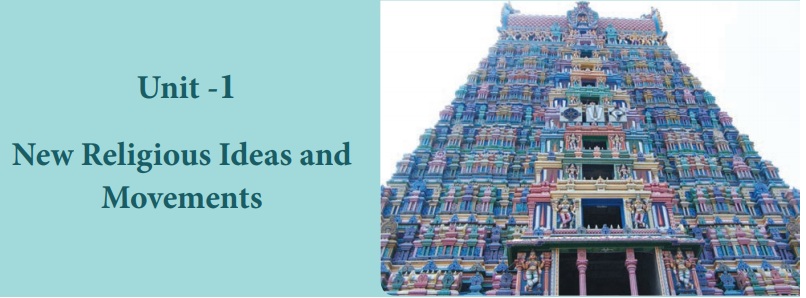
Learning
Objectives
To
acquire the knowledge of
•
Devotional movement of Azhwars and Nayanmars
•
Advaita philosophy of Adi Shankara and vishistadvaita of Ramanuja
•
Bhakti cult in Northern India and its prominent exponents
•
Interaction between Hinduism and Islam, leading to the birth of new cults
notably Sufism
•
Teachings of Kabir and Guru Nanak
•
Impact of Bhakti Movement
Introduction
Medieval
India saw an extraordinary production of devotional poetry, which were not
restricted to one particular religion but inspired by different religious
movements. The exponents of these movements held the view that total devotion (bhakti)
to God could save man from the pitfalls of life and earn him salvation. It was
also believed that one does not have to go to temples or perform rituals, for
God is omnipresent and resides inside every human. The Bhagavad Gita
proposed that the path of bhaktimarga (the path of bhakti) is
superior to the two other religious approaches, namely, the path of
knowledge (jnana) and the path of rituals and good works (karma),
providing inspiration to the exponents of Bhakti cult.
Bhakti Movement: The Beginnings
The
Bhakti movement, or the resurgence of devotional practices, started in Tamil
Nadu around seventh century A.D. It included reciting the name of the God or
Goddess, singing hymns in their praise, wearing religious marks or carrying
identity emblems, and undertaking pilgrimages to sacred places associated with
the deity. It emphasised the mutual emotional attachment and love of a devotee
towards a personal God and of the God for the devotee.
This view was also preached by Sufism,
which appeared as a reaction against worldliness of the early Islam. Sufis
believed that realisation ofGod can be achieved only through passionate
devotion to God and intense meditation. Sufis were of the view that this type
of meditation would enable the devotee to understand the true nature of God.
They argued that doing so would liberate the devotee from all worldly bonds and
help them become one with God. Several mystical religious movements, in both
Hinduism and Islam,had no hesitationfreely include elements of different faiths
their teachings. ‘There is only one god, though Hindus and Muslims call him by
differentnames’, stated Haridasa.
1. Devotional Movement in Tamizhakam
(Azhwars and Nayanmars)
The Azhwars, the Vaishnavite Bhakti
sages and the originators of Bhakti cult, and theNayanmars, the worshipers of
Siva or the Saivites,composed devotional hymns in Tamil language,dedicated to
their respective gods. Siva-bhakti is associated with Siva’s manifestations on
earth. Poems to Siva and Vishnu, particularlyto Krishna, were composed in Tamil
and otherSouth Indian languages such as Kannada andTelugu. These poet-saints
criticised caste-based social status and advocated gender equality inorder to
make it good to stand the onslaught of Buddhism
or Jainism.
Vishnu-bhakti or Vaishnavism is basedon Vishnu’s avatars (incarnations), particularly Krishna and Rama. The 12 Tamil Azhwars are chiefly known for their immortal hymns.Azhwars stand out distinctly for theircontribution to the promotion of the Bhakti movement. Nammazhwar’sfamelies in1,102-stanzaTiruvaimozhi. Nathamuni collected the4,000 poems of Nammazhwar,in the form of Divya Prabandham. Andal, the only female Azhwar, is another. Periyazhwar, who was earlier known as Vishnu Chittar, made lots of songs on Krishna putting himself in theplace of mother Yashoda. Periyazhvar is said tohave found Andal as a baby in the tulsi gardenat Srivilliputhur temple and adopted her. Shegrew up in the temple town of Srivilliputhurand became known as Andal-she who ruled.The Thiruppavai (The Path to Krishna) andthe Nachiyar Thirumozhi (The Sacred Songsof the Lady) are her celebrated works. Herpoems expressing her love for Ranganatha, theincarnation of Vishnu worshiped at a templeat Srirangam, are used in Vaishnava weddingceremonies in Tamil Nadu.
Vaishnavite Saints (12 Azhwars)
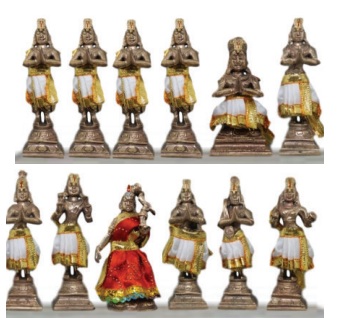
Three Muthal Azhwars: Poigai Azhwar, Bhoothathu Azhwar and
Pei Azhwar.
Other Azhwars: Thirumalisai Azhwar, Periyazhwar,
Thondaradippodi Azhwar, Thirumangai Azhwar, Thiruppanazhwar, Kulasekara Azhwar,
Nammazhwar, Mathurakavi Azhwar and Andal.
Saivite Saints (63 Nayanmars)
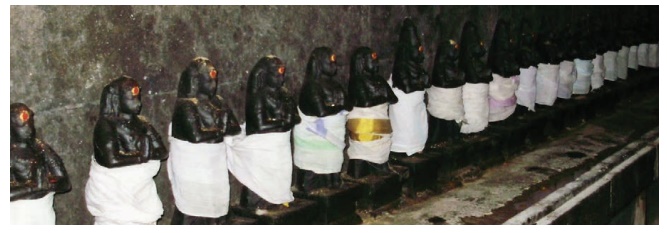
There are 63 legendary
Nayanmars. Among them, Gnanasampandar, Appar, and Sundarar (often called “the
trio”) are worshipped as saints through their images in South Indian temples.
Nambi Andar Nambi (1000 A.D.) is said to have compiled the songs of all of the
Nayanmars that form the basis of Tirumurai, the basic Tamil Saivite sacred
canon. It consists of 12 books, and 11 of them were assembled by Nambi. The
12th book is Sekkizhar’s Periyapuranam.
a. Adi Shankara
AdiShankaraorShankarachariar (c. 700–750
A.D.) preached the Advaitaphilosophy.Theessence of this philosophy is that the
soul (atma) uniteswith the universal soul Adi Shankara (brahma) through
theattainment of knowledge. He set up mathas (mutts), centres of learning and
worship, at Badrinath, Puri, Dwarka and Sringeri. These places have become
prominent pilgrim centres today. Shankara enthusiastically endeavoured to
restore the orthodox Vedic tradition without paying attention to the Bhakti
movement of his time. His masterpiece is the commentary on the Brahma-sutra,
which is a fundamental text of the Vedanta school. His commentaries on the
principal Upanishads are also considered equally important.
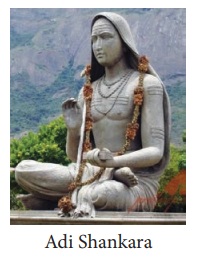
b. Ramanuja
Ramanuja, a 11th century Vaishnava
saint, was the mostinfluential thinker of Vaishnavism. His philosophy, known as
vishistadvaita, proclaims that the soul retains its identity Ramanuja even
after uniting with brahma. After a long pilgrimage, Ramanuja settled in
Srirangam. Ramanuja articulated ideas of social equality and condemned
caste-based restrictions on entering the temples. He established centres to
spread his doctrine of devotion, Srivaishnavism, to God Vishnu and his consort
Lakshmi.
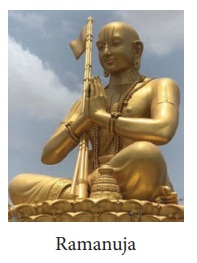
In the 16th and 17th centuries,
Vaishnavism spread across India. The Vadakalai Vaishnavism originally flourished
around Kanchipuram, which was a popular centre for Sanskrit learning. Thenkalai Vaishnavism centred
on Srirangam. Vadakalai sect focused on Vedic literature, which is written in
Sanskrit. The Thenkalai sect stressed the importance of Divya Prabandhams,
written by the 12 Azhwars in Tamil.
2. Bhakti Movement in North India
While
dealing with the religious movements of the fourteenth and fifteenth centuries
in northern India, one has to keep in mind the two very different attitudes
which Hindu religious leaders had towards Islam. One group accepted what was
best in Islam; the other adopted a few elements in order to prevent conversion
to Islam. Both reacted to Islam, but one was sympathetic while the other was
hostile. Kabir and Guru Nanak, and other founders of new sects are included in
the first group, while the movement in Bengal, associated with Chaitanya deva,
or Chaitanya Mahaprabu, belongs to the latter tendency.
a. Exponents of Bhakti Movement
It
was Ramananda who spread the Bhakti ideology in northern India where it became
a mass movement. Vallabhacharya, a Telugu philosopher, built a temple for Lord
Krishna on the Govardhan Hills near Mathura. Surdas, a blind poet and musician,
was associated with this temple as well as that of Agra. His famous collection
of poetry is called Sursagar. Meera Bai, wife of the crown prince of
Mewar, was an ardent devotee of Lord Krishna. She was a disciple of Ravidas.
Meera Bai gained popularity through her bhajans. Chaitanyadeva
popularised Krishna worship through ecstatic songs and dancing that had a
profound effect on Vaishnavism in Bengal. In the 16th century, in Tulsidas’s
Hindi retelling of the story of Rama in the Ramcharitmanas, the
sentiment of friendship and loyalty is stressed. Many of those poems continue
to be recited and sung often at all-night celebrations.
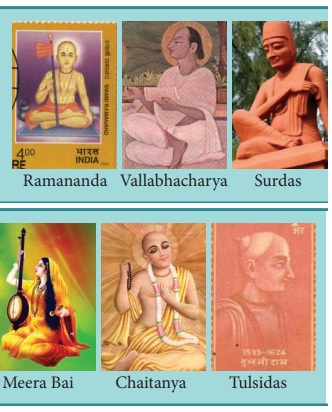
Tukaram, a 17th century
saint poet of Maharashtra, is known for his spiritual songs (abangas or
kirtanas), devoted to Vitthoba, an avatar of Krishna. There is a
Vitthoba/Panduranga temple at Pantharpur or Pandaripuram in Sholapur district,
Maharashtra. What is Chaitanyadeva to Bengal is Tukaram to Maharashtra.
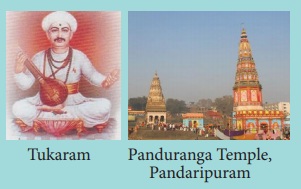
3. Sufism in India
The
advent of Sufis to India dates back to the Arab conquest of Sind. It gained
prominence in the 10th and 11th centuries during the reign of the Delhi
Sultans. Sufism adopted many native Indian concepts such as yogic postures,
music and dance. Sufism found adherents among both Muslims and Hindus.
Sufism: The word
Sufi takes its
origin from suf, meaning
wool. The Sufis
wore course garments made of wool
and hence they were called Sufis. Sufism was basically Islamic but was
influenced by Hindu and Buddhist (Mahayana) ideas. It rejected the stringent
conduct code of the ulemas. Sufis lived in
hermitages akin to
monasteries and functioned
outside society.Sufis
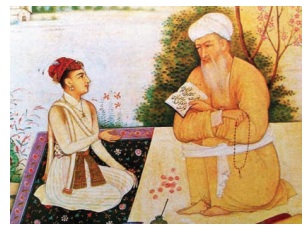
Sufis
in medieval India were divided into three major orders. They were Chisti,
Suhrawardi and Firdausi. Moinuddin Chishti made Chisti order popular in India.
He died in Ajmer (1236) and his resting place is in the Ajmer Sharif Dargah in
Ajmer, Rajasthan. The best known Sufi sage of the early medieval period was
Nizamuddin Auliya of the Chishti order, who had a large number of followers
among the ruling class in Delhi. Poet Amir Khusru was one of its distinguished
followers. Suhrawardi order was founded by an Iranian Sufi Abdul-Wahid Abu
Najib. The Firdausi order was a branch of Suhrawardi order and its activities
were confined to Bihar.
4. (a)
Kabir
As
a Muslim, Kabir came under the influence of Varanasi-based SaintRamananda. He
accepted some Hindu ideas and tried to reconcile Hinduism and Islam.
However,Kabir it was the Hindus,and particularly those of the lower classes, to
whom his message appealed. Kabir believed that God is one and formless, even
though different religious sects give him different names and forms. He opposed
discrimination on the basis of religion, caste and wealth. He also condemned
meaningless rituals. Kabir’s verses were composed in Bhojpuri language mixed
with Urdu. The Kabir’s Granthavali and the Bijak contain collections of Kabir’s
verses.
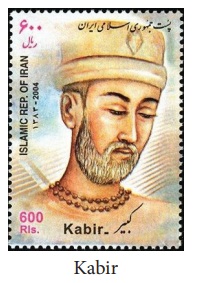
(b) Guru Nanak
Early Life: Guru Nanak, born in a village near
Lahore in 1469, showed interest in religious discussions with other saints
right from his early childhood. His parents were keen to involve him in worldly
life. But he was inclined towards spiritualism. He visited many holy places and
finally settled in Kartarpur near Lahore. He died there in 1539. To mark the
550th birth anniversary of Guru Nanak, a corridor is being constructed by the
Indian government that will link the Nanak shrine in Gurdaspur with Gurudwara
Darbar Sahib at Kartarpur in Pakistan.
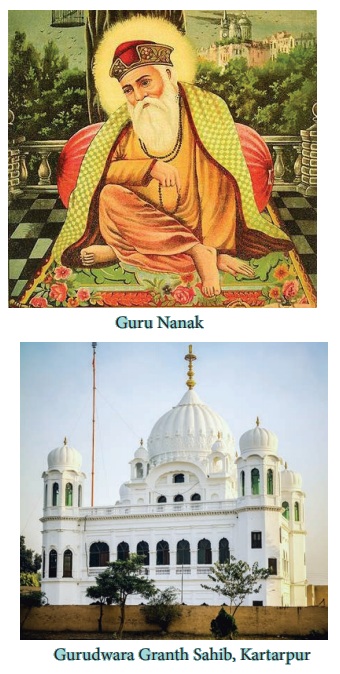
Guru
Nanak’s Teachings:
Guru Nanak preached that God is without
form and wanted his followers to practice meditation upon the name of Godfor
peace and ultimate salvation. He is considered the first guru by the Sikhs.
Guru Nanak had great contempt for Vedic rituals and caste discriminations. The
teachings of Guru Nanak formed the basis of Sikhism, a new religious order,
founded in the late 15th century. His and his successors’ teachings are
collected in the Guru Granth Sahib, which is the holy book of the Sikhs.
Guru Nanak’s teachings were spread through the group singing of hymns, called kirtan.
The devoteesgathered in (rest houses), which became gurudwaras in course of
time.
Guru Nanak nominated his disciple
Lehna to succeed him as the guru. Following this precedent, the successors are
named by the incumbent Sikh Guru. At the time of Guru Gobind Singh, the custom
of pahul (baptism by sweetened water stirred with a dagger) was
introduced.
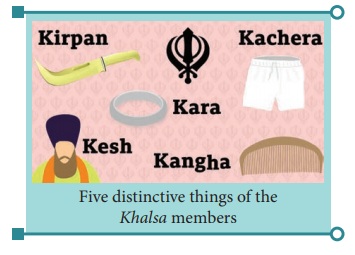
Those who got baptised became
members of a disciplined brotherhood known as the Khalsa (meaning the
pure). The men were given the title Singh (lion). Every member of the Khalsa
had to have five distinctive things on his person. These were kesh
(uncut hair), kangha (comb), kirpan (dagger), kada (steel
bangle) and kachera (underpants). After Guru Gobind Singh, the
holy book Guru Granth Sahib is considered the guru and its message is
spread by the Khalsa.
5. Impact
of the Religious/ Bhakti Movement
*
Vedic Hinduism was regenerated and thus saved from the onslaught of Islam.
*
The Islamic tenets – unity of God and universal brotherhood – emphasised by the
saints promoted harmony and peace.
*
Bhakti was a movement of the common people; it used the language of the common
people for its devotional
literature.
*
Bhakti movement opened up space for Indian languages to grow. It stimulated
literary activity in regional languages.
*
What sustained Sanskrit, despite its decline during this period, was the
support extended by the rulers of Hindu kingdoms.
*
Tamil was the only ancient Indian language remained vibrant during this period.
But the ethos of Tamil literature in medieval time had changed. In the
classical period, it had secular literature depicting the everyday life, its
joys and sorrows, but under the influence of devotional cults, its emphasis
shifted to religion and religious literature.
*
Caste system and social disparities came to be criticised.
Summary
* The Bhakti movement is explained.
Azhwars’ initiatives followed by Nayanmars in Tamil country are described.
*
Adi Shankarar’s advaita philosophy and Ramanujar’s vishistadvaita philosophy
are explained.
*
The devotional paths of saints, notably Tulsidas and Meera Bai, in northern
India and Chaitanyadeva in Bengal are examined.
*
Mutual influence of Islam and Hinduism and birth of Sufism, Sikhism and mystical
Hinduism are discussed in brief.
*
Radical versions of Bhakti Movement: Contribution of Kabir and Guru Nanak are
detailed.
The
essential features of Bhakti Movement are highlighted.
*
The impact of the Bhakti Movement on the medieval Indian society is analysed.
References
1.
R. Champakalakshmi, Religion, Tradition
and Ideology in Pre-Colonial South India, Oxford University Press, 2011.
2.
Burton Stein, A History of India, Oxford University Press, 2004.
3.
Abraham Eraly, Emperors of the Peacock Throne, Penguin, 1997.
4.
https://www.britannica.com.
Glossary
1.
salvation a way of being saved from
danger, loss or harm நிவர்த்தி,
விமோசனம்
2. omnipresent
present everywhere at the same time எங்கும்
நிறைந்திருக்கின்
3. incarnation a living being embodying a deity or spirit அவதாரம்
4. hostile
showing enmity or dislike, unfriendly விமரோதமாக,
பகைமையுள்ள
5. prominence importance முக்கியத்துவம்
6. adherent
supporter (of a person, cause or
belief) ஆதரவாளளர்,
பின்ற்றுபவர்
7. stringent
severe, harsh கடுமையான,
கெடுபிடியான
8. Ulema
Islamic scholar trained in Islamic
law இஸ்லமியப்
பேரறிஞர்
9. hermitage
the dwelling of persons living in seclusion ஆசிரமம்,
துறவி
வாழிடம்
10. akin
similar ஒத்த
இயல்புடைய
11. dagger
short, pointed knife that is sharp on both sides குத்துவாள,
குறுவாள
12. depicting
showing, portraying சித்தரிக்கும், விவரமாக
விளளக்கும்
13. disparity
a great difference, the state of being unequal வேறுபாடு,
சமமற்ற
Related Topics